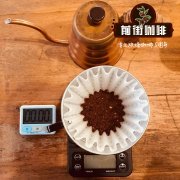New Season Papua New Guinea Estate Grade AX Coffee Bean Recommended_PNG Coffee Bean Grading System

Professional coffee knowledge exchange more coffee bean information please follow the coffee workshop (Wechat official account cafe_style)
PAPUA NEW GUINEA Papua New Guinea Coffee
About 75% of coffee and tea farmers in Papua New Guinea come from small local farms. Many farms reclaim land in the forest, and some are in the depths of the forest, almost isolated from the rest of the world. The country's coffee beans are of high quality because they are grown in the highlands of 1300 Murray 1800 meters above sea level. Although coffee is also grown in some lowlands, the yield is relatively small. Papua New Guinea has established its position as a specialty coffee brand since 1937, when bourbon species from the Blue Mountains were first planted. Papua New Guinea has a detached and primitive natural environment, and the land is vast and fertile. Its unique volcanic rock soil and rich rainfall create excellent natural conditions for the growth of coffee.
Small-scale coffee farms in alpine areas mainly grow this kind of coffee, which has a natural environment similar to that of the Blue Mountains in Jamaica. The plateau, which is 1600 meters above sea level, also has an ideal environment for coffee cultivation, such as rich rainfall and soil. In addition, from the cultivation of coffee trees to cleaning, coffee production is not only based on decades of certified standards for quality management, almost all varieties are cultivated with Arusha and Typica, so the maximum quality of consistent coffee is produced. Papua New Guinea pure natural high-quality coffee, lively and changeable flavor, full particles, light acidity, sweet and round taste, a variety of taste.
Many people think that coffee in Papua New Guinea (hereinafter referred to as PNG) must be similar to Indonesian coffee, but in fact they are completely different.
Papua New Guinea coffee has not been cultivated for a long time, first planted in the 1890s. The earliest PNG coffee was not used for commercial purposes. In 1926, 18 estates began to use imported Jamaican Blue Mountain coffee seeds for coffee cultivation, so it was not until 1928 that PNG really entered the commercial coffee cultivation.
Coffee cultivation in PNG began to grow on a large scale in the 1950s, and the government began to build a lot of infrastructure to ensure the growth of the coffee industry.
In the 1970s, PNG's coffee production continued to grow as the decline in Brazilian production affected the global coffee market. The government has funded a series of projects to further encourage the cooperative operation of small farms. At that time, the whole industry paid more attention to the management of the manor, but the whole industry began to carry out decentralization reform since the 1980s. As a result of the fall in coffee prices, a large number of estates began to fall into an economic crisis, but small landowners were able to continue to grow coffee because they would not be affected.
Traceability:
Some large estates have been very successful, so we are likely to find coffee beans from a single manor. Because traceability is a new concept, many farmers used to sell coffee in one place. Selling in fixed producing areas can be said to be a new concept in this country. In spite of this, altitude and soil make this country's coffee has considerable potential, which has led to PNG's great interest in the international boutique market in recent years.
Taste tendency:
High-quality Papua New Guinea coffee often has a butter-like texture, high sweetness and complex and wonderful flavor.
Grading system:
According to the quality grade export, the quality grade is from good to bad: AA,A,X,PSC and Y. The first three grades come from manor coffee, and the last two grades are grown by small farmers. PSC means Premium Smallholder Coffee (quality small farmer coffee).
Population: 7060000
2013 production: 60000 tons
Most of Papua New Guinea coffee is produced in the highlands, and PNG shows great potential to produce high-quality coffee in the future. PNG also has a small amount of coffee that is not produced in the highlands.
East Highlands:
The East Heights is the only part of PNG that runs through the mountains.
Altitude: 400-1900 m
Production season: April-September
Variety: bourbon, Tibica, Arusha
West Highlands:
This is another important coffee growing place for PNG. Much of the region's coffee is grown around the capital of Mount Hagen, named after an old extinct volcano. Coffee in this area is stored in Goroka, so the origin of coffee in this area is more difficult to track. High altitude and fertile soil make it possible to produce high-quality coffee in this area.
Altitude: 1000-1800 m
Production season: April-September
Variety: bourbon, Tibica, Arusha
Simbu province
Simbu is the third largest producing area, but its output is significantly lower than that of the first two producing areas. Coffee in this area is mainly produced by small farmers. Basically 90% of the population in this area is growing coffee, which is the only cash crop they grow.
Altitude: 1300-1900 m
Production season: April-September
Variety: bourbon, Tibica, Arusha
END
Important Notice :
前街咖啡 FrontStreet Coffee has moved to new addredd:
FrontStreet Coffee Address: 315,Donghua East Road,GuangZhou
Tel:020 38364473
- Prev

What is the variety of coffee beans in the Little Blue Mountains? characteristics of Baroida Baroda Manor in Papua New Guinea
Professional coffee knowledge exchange more coffee bean information Please pay attention to Coffee Workshop (Wechat official account cafe_style) Baroda Farm is a small family farm located in the eastern highlands of Papua New Guinea. I do not know whether it is luck or planning, the quality of the coffee grown on this farm is quite good. Original name: Papua New Guinea Baroida Plan
- Next

Why is the Paradise Bird Coffee at Sigri Manor in Papua New Guinea called the Little Blue Mountain of Asia?
Professional coffee knowledge exchange more coffee bean information please pay attention to the coffee workshop (Wechat official account cafe_style) Papua New Guinea coffee production history is not long. Although coffee cultivation began in the 1890s, it was not initially regarded as a commercial product. In 1926, 18 estates were established, using Blue Mountain Coffee (Blue Mount) from Jamaica.
Related
- Detailed explanation of Jadeite planting Land in Panamanian Jadeite Manor introduction to the grading system of Jadeite competitive bidding, Red bid, Green bid and Rose Summer
- Story of Coffee planting in Brenka region of Costa Rica Stonehenge Manor anaerobic heavy honey treatment of flavor mouth
- What's on the barrel of Blue Mountain Coffee beans?
- Can American coffee also pull flowers? How to use hot American style to pull out a good-looking pattern?
- Can you make a cold extract with coffee beans? What is the right proportion for cold-extracted coffee formula?
- Indonesian PWN Gold Mandrine Coffee Origin Features Flavor How to Chong? Mandolin coffee is American.
- A brief introduction to the flavor characteristics of Brazilian yellow bourbon coffee beans
- What is the effect of different water quality on the flavor of cold-extracted coffee? What kind of water is best for brewing coffee?
- Why do you think of Rose Summer whenever you mention Panamanian coffee?
- Introduction to the characteristics of authentic blue mountain coffee bean producing areas? What is the CIB Coffee Authority in Jamaica?

